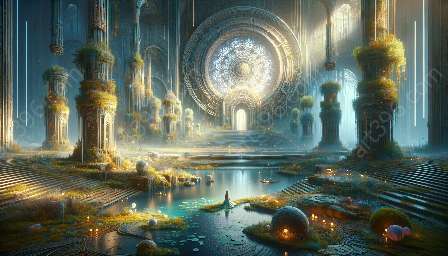In the realm of concept art, creature design holds a fascinating place, drawing from psychological archetypes to create captivating and compelling visuals. This article delves into the psychological archetypes often reflected in creature design, shedding light on the convergence of concept art and creature design.
The Impact of Psychological Archetypes
When it comes to conceptualizing creatures in art, understanding psychological archetypes can significantly impact the design process. Psychological archetypes, as proposed by Carl Jung, are universally present symbols and themes that are deeply ingrained in the human psyche. These archetypes often manifest in art, literature, and other forms of creative expression, and creature design for concept art is no exception.
The Heroic Archetype
One of the psychological archetypes often reflected in creature design is the heroic archetype. This archetype embodies qualities such as bravery, strength, and resilience. In creature design, heroic archetypes can be seen in the form of powerful and majestic creatures that exude a sense of heroism and nobility. These creatures often stand as symbols of courage and leadership, captivating viewers with their commanding presence.
The Shadow Archetype
Contrastingly, the shadow archetype is another psychological element frequently integrated into creature design. The shadow archetype represents the darker, repressed aspects of the human psyche, often associated with fear, chaos, and mystery. In creature design, this archetype is manifested in the form of menacing and enigmatic creatures, evoking a sense of unease and intrigue. These creatures challenge viewers to confront their fears and delve into the depths of their subconscious.
The Wise Sage Archetype
Moreover, the wise sage archetype serves as a significant source of inspiration for creature design in concept art. Creatures embodying the wise sage archetype exude wisdom, knowledge, and profound insight. Often depicted as ancient and mystical beings, these creatures captivate viewers with their enigmatic allure and serve as guides or mentors within the visual narrative.
The Trickster Archetype
Another fascinating archetype often mirrored in creature design is the trickster archetype. This archetype embodies cunning, mischief, and unpredictability. In creature design, trickster archetypes are brought to life through creatures that challenge conventional norms and perceptions, infusing whimsical and unpredictable elements into the visual storytelling.
Concept Art and Creature Design Convergence
The convergence of concept art and creature design provides a platform for the exploration and expression of psychological archetypes. Through meticulous rendering and conceptualization, artists bring these archetypes to life, infusing their designs with layers of meaning and symbolism. The symbiotic relationship between concept art and creature design enables artists to tap into the depths of the human psyche, evoking emotional responses and sparking imaginative journeys.
By integrating psychological archetypes into creature design, concept art transcends mere visual representation and evolves into a powerful form of storytelling. Each creature becomes a vessel for conveying profound themes, emotions, and narratives, resonating with audiences on a deeper level.
Conclusion
In conclusion, the incorporation of psychological archetypes enriches creature design for concept art, adding depth and resonance to the visual storytelling. By understanding and harnessing these archetypes, artists breathe life into their creations, inviting viewers into a world where archetypal symbolism intertwines with artistic imagination. Creature design becomes a reflection of the human experience, inviting contemplation and exploration.

